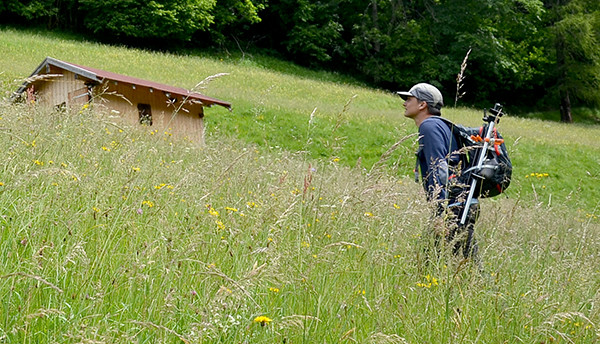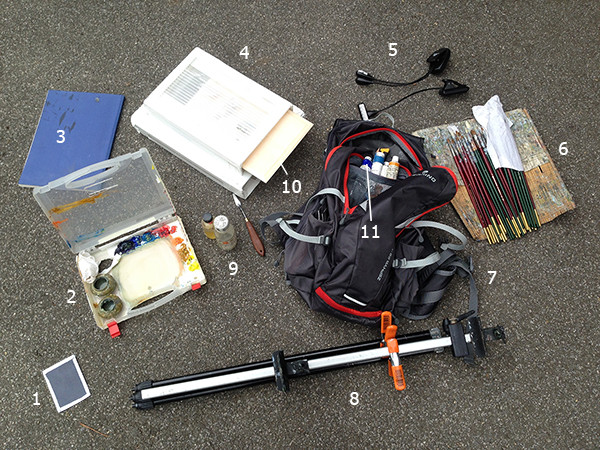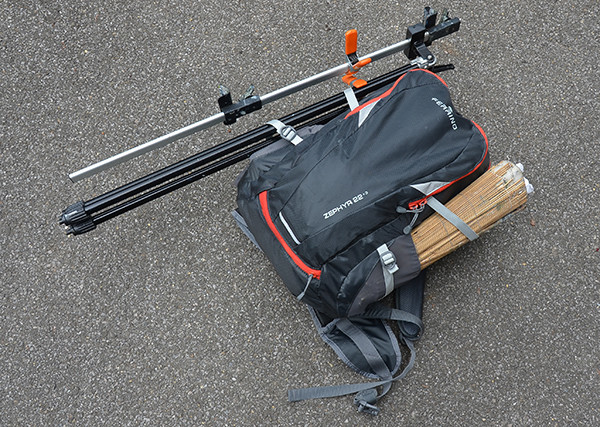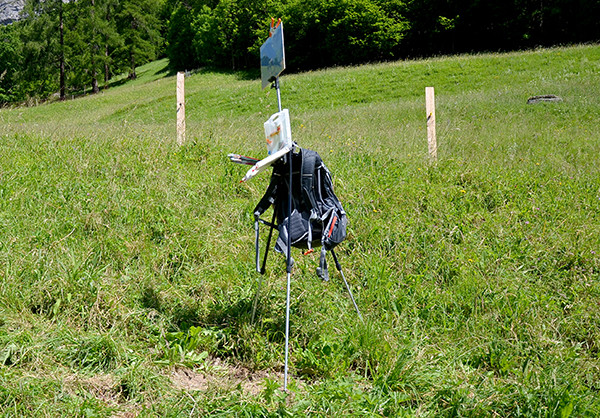2018 Update: This post has been updated with newer information here.

♫ The hills are alive… ♫
Trudging through the snow in the Alps this February, I decided that my plein air equipment was annoyingly heavy and I resolved to lighten it. One major problem outdoor landscape painters have with regard to equipment is that we need it to be wonderfully light while we’re trekking around looking for views, and then we need it to be heavy and stable when we start painting.
I believe that some of this is also just a question of getting used to painting with a different set-up. When I first started landscape painting I used the heavy steel easels made by Fome in Italy. When I tried their aluminum version I found it to be annoyingly unstable. Now I use that same aluminum easel everyday without issues. In my quest for lighter gear I recently tried repurposing a plastic box from a hardware store and had the same experience. The first few times I found it moved too much and seemed unstable, but after sticking with it for a few weeks it works fine for me now.
Having equipment blow over in the wind is a bigger problem, but for most breezes the weight of the backpack is enough to stabilize everything. For heavier winds I think the best solution is to have some way of attaching a weight to the set-up when one arrives at the painting site, and finding said weight there. In nature this usually means finding a big rock and in cities it can mean buying a bottle of water.
This is my current set-up (lighterpack.com link).

My ultralight plein air painting equipment.
- Black mirror
- Plastic pochade box with attached palette cups
- Kunst & Papier softcover sketchbook
- Home-made wet panel carrier
- Night lights for nocturnes
- Brushes and brush-holder
- Ferrino Zephyr 22 + 3 backpack
- Fome aluminum tripod easel
- Medium, turpentine, palette knife
- Zecchi gesso-primed panel
- Backup tubes of paint (just white, the three blues, and ochre)
It clocks in at around 11 lbs, or 5 kg, with the easel.

Everything packed up.
My focus here is really on having a painting set-up that works for me, the weight is completely secondary. For example, I won’t give up the ridiculous number of brushes I need to paint with. My Kunst & Papier sketchbook is also quite large, but I find drawing compositional ideas in a small Moleskine-sized sketchbook to be restrictive. (Kunst & Papier has much better drawing paper too).
I only carry titanium white, Roman ochre, cerulean, cobalt and ultramarine blue paint tubes with me. The fact is that the cadmiums last forever on the palette. They don’t dry out, and the tinting strength of Williamsburg is such that I use very little over the course of a day. I find there is almost never a reason to have back-up tubes in the bag. (Another solution is just to take half-empty tubes of everything).
I’m currently using Zecchi’s gesso-prepared wood panels in Europe, but I’ll switch to New Traditions’ C12 Claessens-on-gatorfoam when I’m in the US this summer. With the Zecchi boards I use those orange ‘Pony’ clamps to hold the lid of my pochade box and the top of the panel. With New Traditions, the clamps are too strong and will crush the gatorfoam so I switch to lightweight (plastic) photographer’s clips. The New Traditions’ boards are quite expensive, but I know people who are making their own version with their preferred primed-linen attached to gatorboard, dibond, or wood via sheets of Beva 371 thick film (glue) using a low-temprature iron. Linen mounted on gatorfoam is wonderfully lightweight and can be especially useful for avoiding overweight fees on airplanes.
Obviously, the night lights aren’t necessary unless I’m painting nocturnes.
There are a lot of cottage industry companies these days making ultralight backpacks (here is a good list). The problem with many of the ultralight packs is that they’re often huge for what is essentially a day trip for most plein air painters. They’re also usually minimalist with regard to add-ons and pockets in order to reduce weight. I find the bells and whistles to be really useful on a backpack. I also need a gazillion pockets to sort everything. Furthermore, having everything waterproofed is useful as medium leakage is a standard occupational hazard for landscape painters and it’s good to be able to protect the other items in the pack from such an event.
At the moment I’m using a Ferrino Zephyr 22 + 3. It’s not an ultralight pack as there is a frame that pushes the body of the bag away from one’s back which seems relatively heavy. (Frankly, the frame doesn’t seem that well thought out as it pushes too far into the main section so it doesn’t leave a great deal of space inside). I bought it after trying on a dozen or so backpacks in various stores as it was very comfortable and the pockets were the right size for my equipment. It’s been holding up well, but I plan on having one custom made after the summer. I’d like to organize the storage to fit my materials exactly, and in a way where I can quickly access the items I regularly need while working.

My current set-up in the field.
Many pochade box companies advertise a 30 second set-up time. That seems like a lifetime in plein air painting. My set-up is up and running in closer to 10 seconds.
That said, I’d like to try a carbon fiber camera tripod set up. While the Fome aluminum easels are lighter than most good carbon fiber camera tripods, I’m curious to see if I can get more stability out of carbon fiber. I wrote to Manfrotto/Gitzo and asked them if they could make some attachment parts for plein air painters, but they said they only design their equipment for photographers. (What ingrates. A landscape painter invented photography for them, and this is the thanks we get.) I considered writing to Fome too, but after they started putting rubber in the lids of their turpentine cups I have very low expectations of their design team.
There are some great American pochade box makers these days, but based on the weight of the boxes they’re making they all seem to have sherpas carrying their equipment around. I’m also more interested in the cigar-box-with-separate-mast system that I currently use. The pochade box model doesn’t work for sight-size, unless you’re ok with having your nose in your palette.
So, after not being able to find a strong, stable, and lightweight attachment system for a cigar box and tripod, I’m currently experimenting with making my own carbon fiber equipment at home. I’ll post the results in a few days.
Great post Marc… thanks for the intel.
I was wondering how that plastic bin was working out.
Are you painting when you’re the U.S. this summer ???
If so what part ???
Thanks Todd. I’ll be in New York, California, Maine, Nova Scotia, and Boston.
Thanks for taking the time to do this post. Your equipment suggestions have really been helpful.
I’ve found that even the cheaper camera tripods are fairly stable as long as you are not using the plate to support the poached box. I switched this spring to a setup where the tripod section supports my open box and a small board is attached to the plate so that i can sight size (via you suggestion). Lowering the box and reducing the weight on the center pole really increased the stability. But my open box, as light as it is, I’m sure can’t compete with the weight of plastic. Cool that you were able to adjust to that.
When you’ll be in Nova Scotia, take a plane from Sydney or Halifax or ask my brother in law, captain on the container ship to bring you to my island, Saint-Pierre & Miquelon, and let’s paint REAL nice seascapes…
Your light box is a good idea; could be useful to run faster when the tide run behind you. Or the bear. Or the girls!
I have the same problem, it’s why i’m trying gouache.
Bienvenue par chez nous!
Using the cigar box, Italian easel, and sight size. Very useful for light trail and beach hikes here in Laguna, California with the paint group I manage. Still love my French mistress hooked on my heavier tripod legs for painting by the van. I run up the tripod mast to sight size from center mast panel clamp with good low palette weight on the legs. Your input of great use and am inclined to create my own equipment too.
Great post as always! If you are successful with your experiments with carbon-fiber, maybe you can start a kickstarter or something like that ..
If you are gonna do urban stuff in New York City I’ll be super pumped.
I live in Philadelphia but NYC is one of my true loves, my wife and I go about every other month for the weekend and still visit for most vacations.
But the beautiful upstate New York and New England will be great for nature as well.
Best of luck with the trip to the States and if you are gonna be in NYC I’d love to look over your shoulder for 20 mins and then I’ll leave you be 😉
Really cool. Hope you bring it with you. Do you want to do an Art Talk and Demo on the 15th.—the morning after the opening? Happy Day! Gary
Who was the landscape painter who invented photography?
I was referring to Daguerre.
… and a very good painter! Fascinating, and I had no idea he also invented dioramas. I saw Gary Haynes comment above, and his Thomaston gallery is just a town over. If you do decide to do a demo, let me know and I’ll get an announcement sent around to the local Plein Air group.
You have a great about equipment here, and I love the link to the weight tables. But the idea of the plastic paint box just seems wrong! Maybe I’ll see it and I can decide for myself.
Hey Marc, great post on how to minimize the gear. Something I like to do myself.
Here’s another quick tip to add…
If you have a smart phone (with a black screen) you can leave your black mirror/claude glass at home. I didn’t even come up with this idea. A friend in a drawing class pulled her phone out and started using it next to me and it was, well, a genius moment. Here is a post about it on my blog, with photos clearly demonstrating the tool:
http://www.thomaskitts.com/2013/11/high-tech-meets-low-tech-i-was-at.html
Take care and perhaps we will run into each other again in CA soon!
Thomas Jefferson Kitts
http://www.thomaskitts.com
Hi Thomas, I wrote a similar post last year (I had missed yours). I’ll be in California at the end of July if you’re around. I was going to link to your excellent tripod discussion in my next post on carbon fiber gear.
Hi Marc, have you looked at Joseph McGurl’s easel set up? I believe all his plein air work is sight-size. His easel looks like a homemade version of the “Coulter system”. McGurl has a photo of his work “in situ” on his workshop page: http://www.josephmcgurl.com/workshops.html But the best description I’ve read of McGurl’s set up and process is from a student account of one of his workshops: http://brianbuckrell.blogspot.ca/2012/09/weekend-with-masters-joe-mcgurl-workshop.html
Thanks for the comment Tania. I have seen McGurl paint and I’ll paint with him later this summer. As I recall though (and from looking at the photos you linked), his kit doesn’t meet my ten-second-set-up requirement.